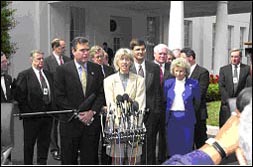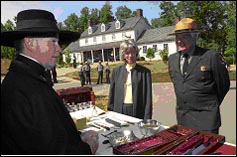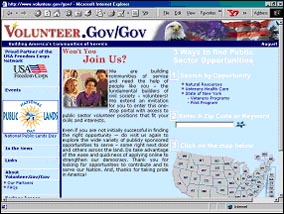INTERIOR
Interior Addresses its Greatest Management Challenges

Secretary Gale Norton and I share a vision of a Department of the Interior that continually improves its delivery of services to the American people while meeting an array of challenges that force us to better manage our programs and business processes. These challenges arise from increased demands for recreation, conflicts as wild lands and urban lands interface, and the public's expectation of information that is not only reliable and accurate but is disseminated in real-time. To help us realize our vision, Secretary Norton has identified a process for effectively managing our programs. We call this her "4 C's." They are "conservation through cooperation, consultation and communication."
 By cooperating, consulting, and communicating with those that we serve, the Secretary and I believe Interior will find ways to meet our challenges and forge innovative partnerships to improve and
optimize our services.
By cooperating, consulting, and communicating with those that we serve, the Secretary and I believe Interior will find ways to meet our challenges and forge innovative partnerships to improve and
optimize our services.
Expanding E-Government: A Call for Volunteers
Each year, people volunteer millions of hours to help deliver Federal agencies' missions for the American public. But there's a problem. Applicants have to contact each Federal volunteer program one at a time in order to identify a volunteer opportunity. This is often confusing and time-consuming.
Enter volunteer.gov/gov, a web-based, one-stop for Federal volunteer opportunities. The site was developed through a partnership with other Federal agencies. Though we are still grappling with
 challenges such as viable mechanisms that can be used to help fund multi-agency projects like this one, the site does fill a major need. It allows potential volunteers to locate, search, and apply on-line, creating a virtual market for volunteers and volunteer opportunities. If your agency uses volunteers, check out the site, and consider joining us as a partner.
challenges such as viable mechanisms that can be used to help fund multi-agency projects like this one, the site does fill a major need. It allows potential volunteers to locate, search, and apply on-line, creating a virtual market for volunteers and volunteer opportunities. If your agency uses volunteers, check out the site, and consider joining us as a partner.
Expressly Competitive Sourcing
Interior's Center for Competitive Sourcing Excellence (CCSE) provides a "one-stop" for accessing, reporting, and tracking information related to department-wide competitive sourcing.
Interior has many small offices performing commercial activities. One of the CCSE's key contributions to date has been obtaining OMB approval for Interior offices and bureaus to perform cost comparison studies involving functions with 10 or fewer government employees. We've dubbed this "Express Review". We want to empower employees in small work units to compete for work they perform. An Express Review can often be completed in as little as 60 days, for a whole lot less money than full-fledged A-76 studies.
See http://www.doi.gov/pam/competitivesourcing/ ; click on "Department of the Interior Guide for Conducting an Express Review."
Red Light-Green Light
With 70,000 employees scattered over 2,500 office locations, Interior knew it needed a way to get everyone pulling together when OMB's multi-colored management scorecard arrived on Secretary Norton's desk.
We adopted our own bureau-level scorecard, expanding the three-color scheme over a scale of 0-10, to more readily recognize progress. We developed more detailed scoring criteria with our bureaus, customized to DOI's situation in a way that the universally applicable OMB scorecard is not. Finally, instead of the Secretary handing out report cards, we told the bureaus to self-grade. We applied this scorecard the first time in May 2002.
 To get people focusing more on what needs to be done to make progress instead of how best to explain any current problems identified by scores, we promised our bureaus that we would not release scores outside of Interior. Our self-grading exercise has revealed excellent information. For example, we found that on average, the May scorecard showed our bureaus scored relatively low in budget and performance integration, and relatively high in E-Government. We are working closely with bureaus to develop actions that will improve their scores and ultimately get them to green. We are now using the self-grading results to develop "to-do" lists for each bureau to improve, identify best practices to replicate Department-wide, and identify recurring problems that need Department-wide attention. An example of the DOI scorecard can be found at http://www.doi.gov/ppp/scorecard.html.
To get people focusing more on what needs to be done to make progress instead of how best to explain any current problems identified by scores, we promised our bureaus that we would not release scores outside of Interior. Our self-grading exercise has revealed excellent information. For example, we found that on average, the May scorecard showed our bureaus scored relatively low in budget and performance integration, and relatively high in E-Government. We are working closely with bureaus to develop actions that will improve their scores and ultimately get them to green. We are now using the self-grading results to develop "to-do" lists for each bureau to improve, identify best practices to replicate Department-wide, and identify recurring problems that need Department-wide attention. An example of the DOI scorecard can be found at http://www.doi.gov/ppp/scorecard.html.
---Steve Griles, Deputy Secretary, Department of the Interior
Department Updates:



